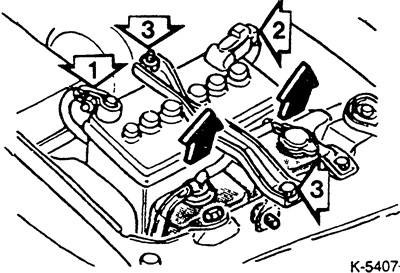Attention: When the battery is disconnected, the contents of the failure memory of the engine control, anti-lock brake system, as well as other permanent devices are erased (e.g. setting the time on the clock and programming the radio). Before disconnecting, contact a service station for a memory poll. After connecting the battery, the relevant devices must be reprogrammed.
In addition, non-serial receivers are equipped with a security coding system. The security coding system does not allow the receiver to be turned on after a power failure. Power can be interrupted not only when the cables are removed from the battery, but also when the radio is removed or the corresponding fuse blows. If the receiver is coded, you should know the code before removing the cables from the battery. If the code is unknown, only the radio manufacturer can put the receiver back into operation.
Removing
Turn off the ignition and vehicle lights. In this way, failure of electronic control units can be avoided (e.g. engine control unit).
Open the hood of the engine compartment. The battery is in the compartment.

Disconnect the ground wire -1- and then the positive wire -2- from the battery.
Detach retaining plastic -3- and remove.
Remove battery.
Caution: Batteries contain toxic substances that should not be disposed of with normal household waste. Take old batteries to special waste collection points.
Installation
Before installation, process the battery poles to a shine with a metal brush. To prevent corrosion, coat both poles with a special acid-resistant compound, eg BOSCH-Polfett.
Install battery.
Install the retaining plate without tightening too much.
Connect the positive wire to the positive pole (+), and then the ground wire to the negative pole.
Caution: Connecting the battery with reverse polarity can cause significant damage to the alternator and other electrical devices.
Put the plastic cover on the positive terminal.
If necessary, reprogram the radio.
Set the time on the clock.
